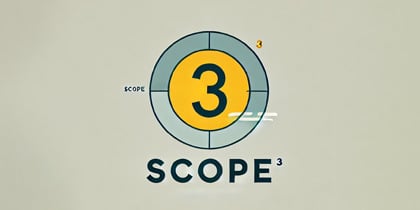What is Scope 3? This question is increasingly important in today's era of sustainability. Scope 3 emissions are greenhouse gases that result from indirect activities in an organization's value chain. This includes both upstream and downstream emissions, from the production of raw materials to the use and disposal of finished products. Scope 3 can be seen as complementary to Scope 1 and Scope 2 emissions, each of which includes direct emissions and indirect emissions from energy consumption.
Breakdown Scope 3 into 15 categories
Scope 3 emissions are divided into 15 categories, each with specific sources of emissions:
- Purchased goods and services
- Capital goods
- Fuel and energy related activities (not included in Scope 1 or Scope 2)
- Transportation and distribution (upstream)
- Waste generated in operations
- Business travel
- Commuting by employees
- Leased assets (upstream)
- Transportation and distribution (downstream)
- Processing of products sold
- Use of sold products
- End-of-life treatment of products sold
- Services sold
- Leased assets (downstream)
- Investments
The importance of Scope 3
Why is Scope 3 so important? Scope 3 emissions often make up the largest portion of an organization's total carbon footprint. By measuring and managing these emissions, companies can make significant environmental gains. It also helps identify risks and opportunities in the supply chain, which can lead to improved efficiency and cost savings.
In addition, stakeholders, such as customers and investors, are increasingly demanding transparency and accountability on environmental impacts. By providing insight into Scope 3 emissions, companies can improve their reputation and meet the growing demand for sustainability.
Challenges in measuring Scope 3
Measuring Scope 3 emissions is complex and challenging. The diversity of sources and reliance on data from external parties complicate the process. Companies must collect detailed and accurate data on their entire value chain, which can be time-consuming and costly.
In addition, it can be difficult to obtain reliable information from suppliers and other partners. This lack of transparency and control makes measuring Scope 3 emissions a difficult task. Fortunately, there are strategies that can help companies overcome these challenges.
Working with suppliers
A key strategy for managing Scope 3 emissions is to collaborate with suppliers. Through open communication and partnerships, companies can encourage their suppliers to work more sustainably. This can include establishing clear sustainability goals and expectations, as well as providing training and resources to help suppliers meet these expectations. In addition, companies can reward suppliers who demonstrate outstanding sustainability performance.
Innovating product design
Innovating product design can also help reduce Scope 3 emissions. By designing products with sustainability in mind, companies can reduce the environmental impact of their products throughout their life cycle. This can be done, for example, by using recyclable or renewable materials. Or by incorporating maintenance, component replacement or extended life into the design. It also includes minimizing packaging materials or choosing environmentally friendly options.
Optimizing logistics
Logistics play a major role in Scope 3 emissions. Companies can optimize their logistics processes to reduce emissions by choosing more efficient transportation methods, optimizing route planning to reduce fuel consumption and working with logistics partners who embrace sustainable practices.
An opportunity for a sustainable future
Managing Scope 3 emissions is a challenge, but also an opportunity. By focusing on Scope 3, organizations can significantly reduce their overall carbon footprint and contribute to a more sustainable future. Despite its complexity, managing Scope 3 emissions offers valuable insights and benefits beyond one's own organization.
Want to learn more about Scope 3 and how the insights from our reports provide effortless insight into it, in the area of waste? Book an introductory appointment.
Stay up to date
Stay up to date on all new developments? Follow us onLinkedIn and Instagram or subscribe to ournewsletter. Are you curious about what Milgro can do for your operations and waste process? Then get in touch.












